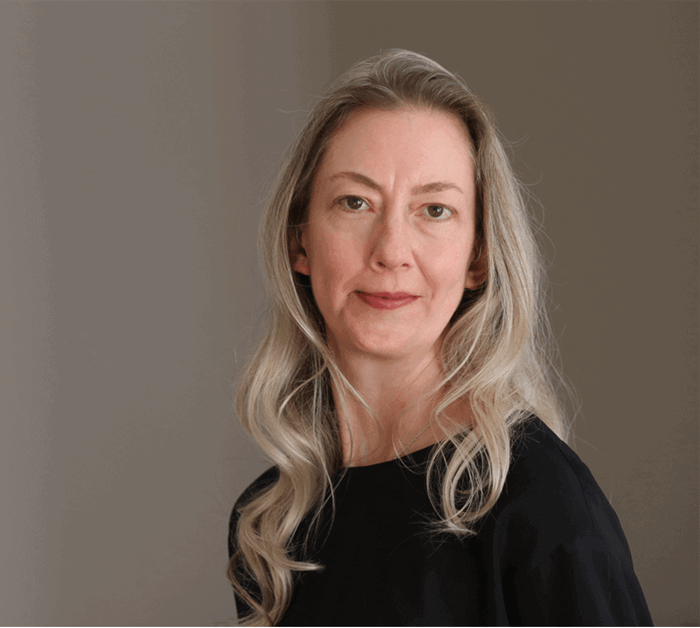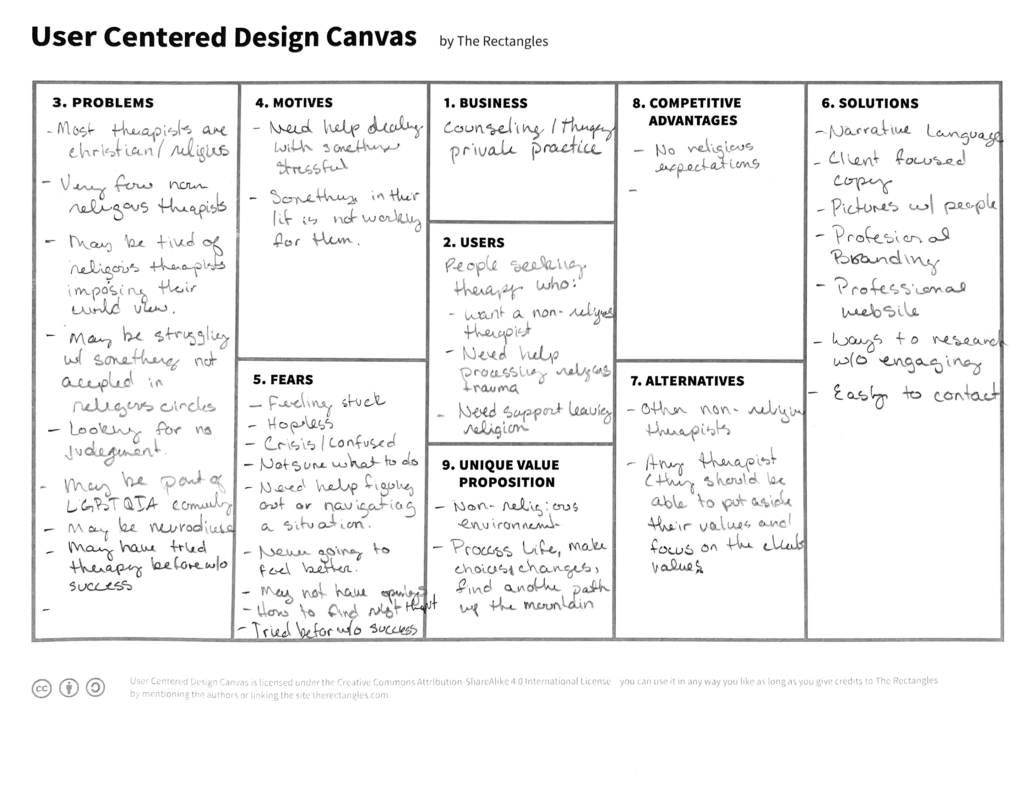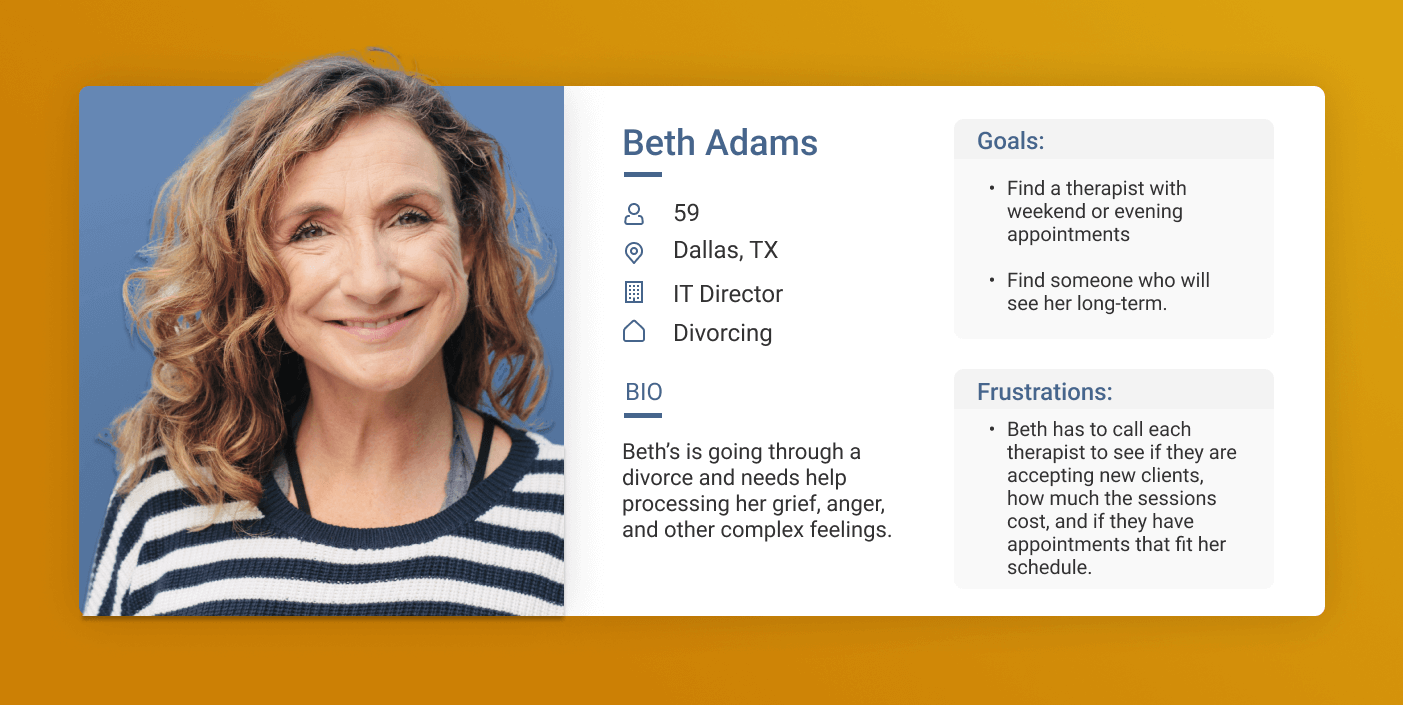GOLDFINCH COUNSELING
How do people choose a
mental health counselor/therapist?
The Project
A counseling student wanted to create a compelling private practice website while still a student. Most therapists wait until they are licensed before working on the business aspect of a private practice.
It normally takes six to twelve months to fill a private private practice with clients, so by starting early, the therapist-to-be hoped to get the practice up and running by the time she was licensed.
THE TIMELINE
2022 – Initial research and design


MY ROLE:
- Sole UX Designer
RESPONSIBILITIES:
- Strategy and planning
- Stakeholder Interview
- User Interviews
- Competitive Analysis
- User Research Insights
- Personas
The Problem
Most therapists have terrible websites because they design the websites themselves, which reduces their credibility in the eyes of potential clients. A professional website is a therapist’s #1 marketing tool and is essential for gaining private-pay clients.
The Goal
Happy Finch Counseling wanted to leverage UX Design to discover how potential clients choose a therapist and use that information to design a compelling professional private practice website using proven modern design elements and inbound digital marketing strategies.
A therapist’s website must focus on what the client hopes to achieve in therapy while also instilling confidence that the therapist can help.
PREPARING THE RESEARCH
User Research Overview
Stakeholder Interview
Competitive Analysis
USER RESEARCH OVERVIEW
QUALITATIVE RESEARCH
We were interested in hearing stories about how people find mental health professionals. Our questions were more about the process rather than why they needed help. We were particularly interested in the challenges they encountered and why they picked the therapist they ended up seeing.
CHALLENGE: LACK OF USERS
We did not have a budget to hire a research firm or pay research participants. So, we had to get creative about finding users. We interviewed parents sitting in therapy waiting rooms, professional counseling students who themselves had been to therapy, as well as people we knew in our personal lives.
RESEARCH TIMELINE & MODALITY
The user research took place during a two week period of time, and research was conducted using one of three methods:
- In-person interview
- Phone call
- Zoom video conference
Research participants were asked the same pre-scripted open-ended questions.
3 TYPES OF USERS
We discovered three ways that people seeking a mental health help find a counselor or therapist:
1. Referrals from a trusted medical or mental health professional.
2. Google searches for specific problems and their location.
3. Psychology Today and other directory listings.
STAKEHOLDER INTERVIEW
We used the User-Centered Design Canvas for the stakeholder interview.
The stakeholder interview revealed that the website would be the primary marketing tool with the following requirements:
- Optimized for conversions (booking an appointment).
- Expandable as the practice grows from one therapist to a future group practice.
- Website copy needs to reflect the ideal client’s perspective.
- Optimized for local SEO and be discoverable by “ideal client”.

COMPARATIVE ANALYSIS

Selection Criteria & Goals
After looking through dozens of therapists’ private practice websites, we selected the top seven and performed a comparative analysis. We were interested in the messaging, conversion optimization, local SEO, and how the websites made it easy for potential clients to find the information they were looking for.
Comparative Analysis Insights
- Hero image and hero text were very important in connecting with a potential client.
- Single therapist sites were very different from group practice sites.
- Most were not optimized for conversions.
- Most did not have images of the office or therapy room.
- All had bios and pictures of individual therapists.
UNDERSTANDING THE USER
User Selection
User Goals
User Interview Questions
User Research Insights
Pain Points
USER SELECTION
Because we did not have a budget to hire a research firm or pay research participants, we had to get creative about finding users. We interviewed parents sitting in therapy waiting rooms, professional counseling students who themselves had been to therapy, as well as people we knew in our personal lives.

INTERVIEW GOALS

The goal of our quantitative user research was the listen carefully to the stories people told about their experiences finding a counselor or therapist. We started with a list of nine questions but allowed the conversation to flow, omitting questions that were previously answered and adding new questions when clarification was needed.
INTERVIEW QUESTIONS
Question 1
Think back to the last time you were looking for a therapist and please tell me about the process. We are interested in the process of finding a therapist and not what you were seeking therapy for.
Question 2
What resources did you use in your search for a therapist (referral, listings, websites, Google search, etc.)? What was this experience like?
Question 3
What challenges did you run into when looking for a therapist?
Question 4
What might have made your search easier?
Question 5
Did you look at the therapist’s website? If so, please describe what you did or didn’t like about it (feel free to pull it up and walk me through it).
Question 6
If you were going to look for a new therapist and had you had someone in mind, what would you want to see on their website?
Question 7
When looking at a therapist’s website, are you more drawn to language about what they can help you with or a focus on their background and training? Or something else?
Question 8
How do you feel about seeing pictures of the waiting room and therapy rooms? Is it reassuring?
Question 9
Is it important to see a picture of the therapist? Would a video be helpful/reassuring?
Question 10
Would you rather call to schedule an appointment or book online?
USER RESEARCH INSIGHTS
Interview Insights
Personas
User Journey Maps
Empathy Maps
INTERVIEW INSIGHTS

Insight 1: Experienced Users Start with Directories
Experienced users (those who have had therapy before) often start their search for a therapist on Psychology Today or a directory for their preferred therapy technique or problem area (i.e. OCD, EMDR, etc.).
insight 2: Google Searches are Specific
Many people search Google for their specific problem and their location (i.e. “Allen Texas therapist to help me deal with an alcoholic family member” or “divorce trauma therapist in Little Elm”). Therapists’ websites are usually general in nature and use clinical language, making it hard for potential clients to know if the therapist can help them with their specific issue. Potential clients also struggle with the precise language to use in their searches (i.e. “LGBT therapist for teens” vs. “gender-affirming therapist for adolescents”. Therapists need to use common language on their website and create pages for specific issues.


Insight 3: Three Quick Questions
Users universally struggled to find a therapist with openings who were also in-network with their insurance. They wanted a quick way to find the following:
- Is this therapist accepting new clients?
- Is the therapist in-network with their insurance?
- If insurance is not accepted, how much is a session?
- Are virtual appointments available?
- Are weekend or evening appointments available?
PAIN POINTS
1. I DON'T KNOW WHAT TYPE OF THERAPY I NEED.
It’s not always easy for potential clients to figure out of a therapist can help them with their specific issue. Most therapists can help with many issues, but if the specific issue isn’t listed on the website, the potential client may look for another therapist. Clients may not know what their problem is – only that they are struggling with life.
2. I CAN'T FIND A THERAPIST WHO IS TAKING NEW CLIENTS!
The COVID pandemic sparked a nationwide mental health crisis and potential clients continue to have a difficult time finding therapists who are taking new clients. Often, this information is only available by calling the therapist.
3. I NEED SOMEONE WHO TAKES INSURANCE.
Most clients who have health insurance would prefer to see a therapist in their network. However, more and more therapists are not in-network (due to low reimbursement rates), which can make the search for an affordable therapist very difficult.
4. THERAPY DIDN'T HELP BEFORE. HOW DO I MAKE THIS TIME DIFFERENT?
Because many therapists do not take insurance, knowing the session fee can be vitally important. Many therapists do not put their session fees on their website so the client has to call to get this information.
PERSONA 1: BETH
Beth is going through a messy divorce. She is devastated and needs help processing her grief, anger, and other complex emotions. She needs a therapist who can help her through this difficult time. Only, it’s hard to find a therapist with openings – especially someone who works evenings or weekends.

PERSONA 2: SUSIE

After watching her teen daughter come out as non-binary and pan-romantic, Susie was surprised to find herself jealous that she never got the opportunity to explore her own gender and orientation. She has started to wonder if she might be on the asexual (ACE) spectrum and would like to talk with a gender-affirming therapist who is a member of the LGBTQ community.
PERSONA 3: LYNN
Lynn has been through some significant trauma at her church. She is questioning her religious beliefs and whether or not she wants to be involved with religion anymore. Her entire family and most of her friends are religious, so she needs a safe and non-judgemental space where she can work through her trauma and leave religion. Lynn wants to find a non-religious therapist.

HAPPY FINCH COUNSELING
QUESTIONS?
dannablumenau@gmail.com
214-444-8805
